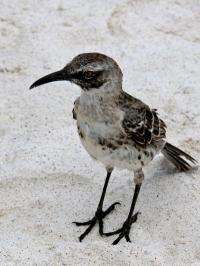A hitchhiker's guide to the Galapagos: co-evolution of Galapagos mockingbirds and their parasites

Along with the famous finches the Galapagos mockingbirds had a great influence on Charles Darwin's theory of evolution. Now, 176 years later, three of the four mockingbird species are among the rarest birds in the world. New research published in BioMed Central's open access journal BMC Evolutionary Biology untangles the evolutionary relationships between Galápagos mockingbirds and provides information about their parasites to help ensure the birds survival.
Researchers from the University of South Bohemia in the Czech Republic, the Natural History Museum London, and the University of Zurich in Switzerland used three parasites specific to the mockingbirds to reveal their coevolutionary history. Mitochondrial and nuclear DNA from the mockingbirds, their feather mites, and also two species of parasitic louse was sequenced. The least host-specific louse showed no pattern of co-evolution with the mockingbirds, but the two other parasites showed very similar evolutionary histories.
Jan Štefka, lead author of the research, said, "Combining DNA data from several organisms that share their history, improves our confidence in the evolutionary patterns we see. In this case the host specific parasites reveal more about the recent evolution of the mockingbirds than the bird data in isolation." He continued, "These results have implications for the conservation and taxonomy of Galápagos mockingbirds. For example the critically endangered Floreana mockingbird is now extinct on the island of Floreana. However, to our surprise, the number of parasites on one of the remaining populations was much less than expected. This suggests that the infestation was probably due to a recent introduction of the parasite from a different island."
Paquita Hoeck from the University of Zurich adds, "Hosts and parasites evolve specific adaptations when living in isolation. To avoid the undesirable spread of parasites or pathogens after a planned re-introduction of mockingbirds back to Floreana, different histories of parasites in the two remaining satellite populations need to be considered."
More information: A hitchhikers guide to the Galapagos: co-phylogeography of Galapagos mockingbirds and their parasites, Jan Stefka, Paquita EA Hoeck, Lukas F Keller and Vincent S Smith, BMC Evolutionary Biology (in press)
Provided by BioMed Central



















